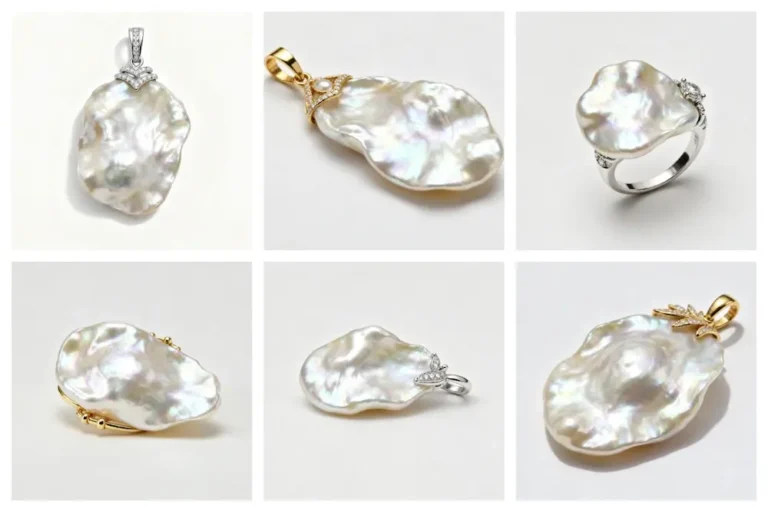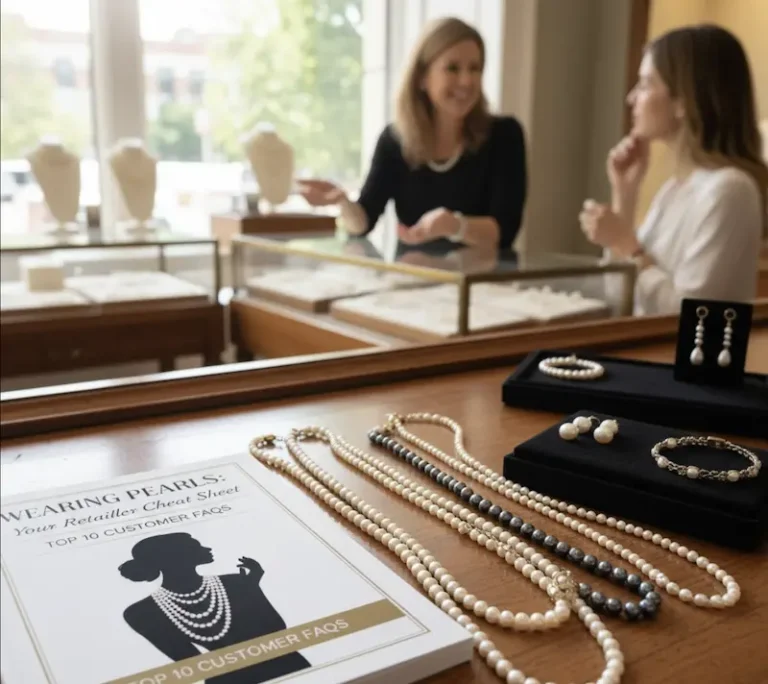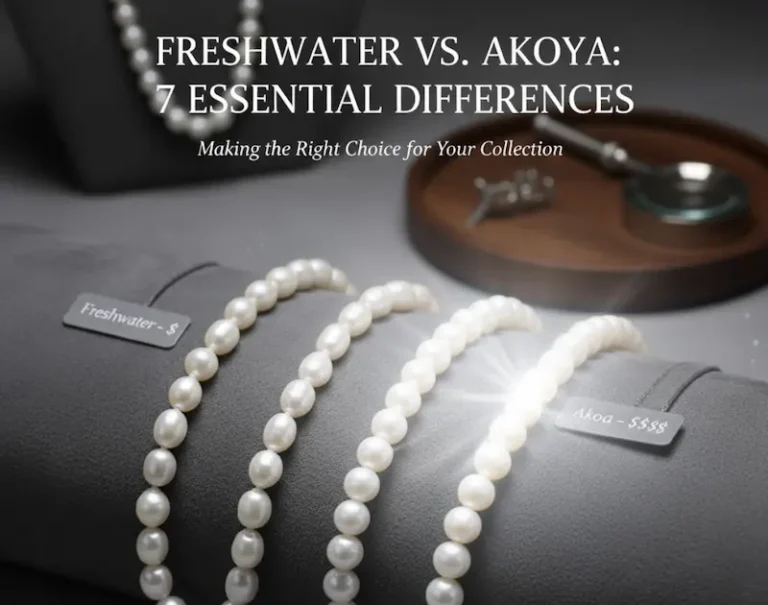Pearls have captivated humanity for millennia with their natural beauty and lustrous appeal. Whether you’re a jewelry enthusiast, collector, or someone looking to make an informed purchase, understanding what are the different types of pearls available today is crucial for making the right choice. From classic Akoya pearls, cost-effective freshwater pearls to exotic Tahitian varieties, each type offers unique characteristics that cater to different tastes, budgets, and occasions.
In this comprehensive guide, we’ll explore the fascinating world of pearl varieties, helping you navigate through the eight most important types that dominate the modern jewelry market. You’ll discover the distinct features, origins, and values of each pearl type, empowering you to make confident decisions whether you’re shopping for wholesale pearls or selecting individual pieces for your collection.
The Two Primary Categories: Saltwater vs. Freshwater Pearls
Before diving into specific varieties, it’s essential to understand the fundamental classification of what are the different types of pearls. All cultured pearls fall into two main categories: saltwater and freshwater pearls. This primary distinction affects everything from the pearl’s formation process to its final characteristics and price point.
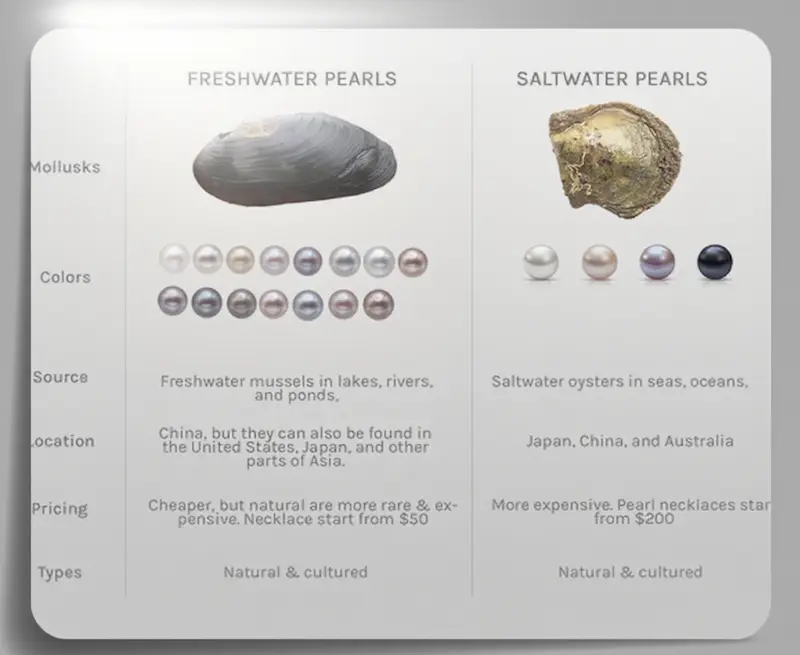
Before we get into the specifics, it’s important to know the basic categories: what are the different types of pearls out there? All cultured pearls fall into two main categories: saltwater and freshwater pearls. This primary distinction affects everything from the pearl’s formation process to its final characteristics and price point.
Saltwater pearls come from the ocean and usually cost more because they have a better shine and are harder to grow. Think of Akoya, South Sea, and Tahitian pearls. Freshwater pearls, on the other hand, are grown in lakes and rivers. They’re a great value and come in all sorts of shapes and colors, making them a popular choice for everyday jewelry as well as fancier pieces.
Key Differences Between Saltwater and Freshwater Pearls
| Feature | Saltwater Pearls | Freshwater Pearls |
|---|---|---|
| Cultivation Time | 1-3 years | 2-6 years |
| Nacre Thickness | Thinner (0.5-1mm) | Thicker (2-6mm) |
| Luster Quality | Exceptional | Good to very good |
| Shape Variety | Primarily round | Wide variety |
| Color Range | Limited natural colors | Extensive natural colors |
| Price Range | Higher | More affordable |
What Are the Different Types of Pearls : 4 Essential Pearl Varieties
Pearls generally come in four main types:
- Akoya Pearls
- Freshwater Pearls
- Tahitian Pearls:
- South Sea Pearls
1. Classic Akoya Pearls: The Gold Standard of Elegance
When most people think about what are the different types of pearls, Akoya pearls are what often spring to mind. These saltwater pearls, mainly from Japan and China, are like the classic symbol of pearl beauty. It’s this perfect roundness and amazing shine that have made them the top pick for those timeless pearl necklaces we all know.
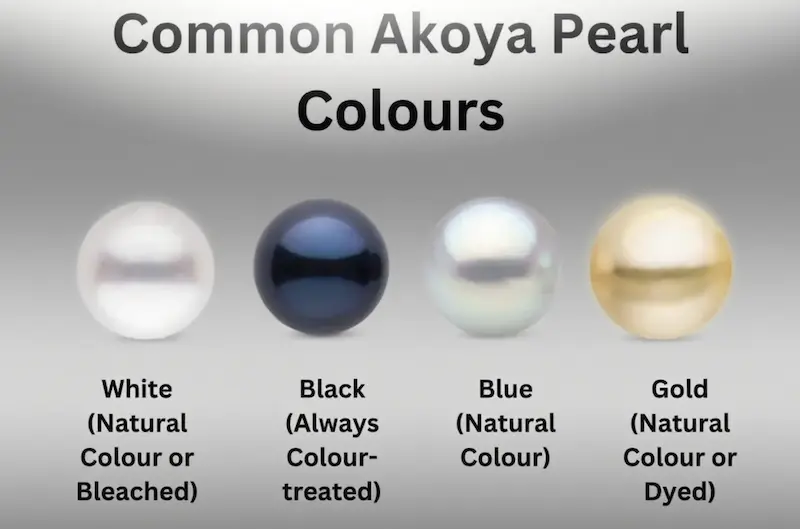
Akoya pearls usually come in sizes from 6mm to 9mm, with 7-8mm being the most popular. It takes about 10-14 months for them to grow, as the Pinctada fucata oyster works its magic to create a single pearl with a really beautiful surface. Grown in the chilly waters of Japan and China, they’re known for their bright white color, often with hints of rose, cream, or silver.
Akoya pearls are awesome because they’re so consistent in size, shape, and color! That makes them ideal for crafting perfectly matched pearl necklace and pearl pendant. especially when you’re selling them in larger quantities. You’ll often see them in bridal jewelry, work outfits, and at fancy events where a touch of elegance is a must. They’re all about sophistication!
What makes Akoya pearls special? Well, they’re famous for their incredible, sharp luster – almost like a mirror! This amazing shine, along with their usually round shape, makes them the benchmark for judging other kinds of pearls. Even though their nacre (the coating that gives pearls their sheen) is fairly thin, it’s really high quality. Plus, they usually have a very clean surface with hardly any imperfections.
2. Magnificent South Sea Pearls: The Luxury Choice
South Sea pearls are really the top of the line when it comes to pearl luxury. When considering what are the different types of pearls available, these are definitely some of the most desirable. These stunning gems come from the warm waters around Australia, Indonesia, and the Philippines. They’re grown in the Pinctada maxima oyster, a big one that can produce pearls anywhere from 9mm to a whopping 20mm!
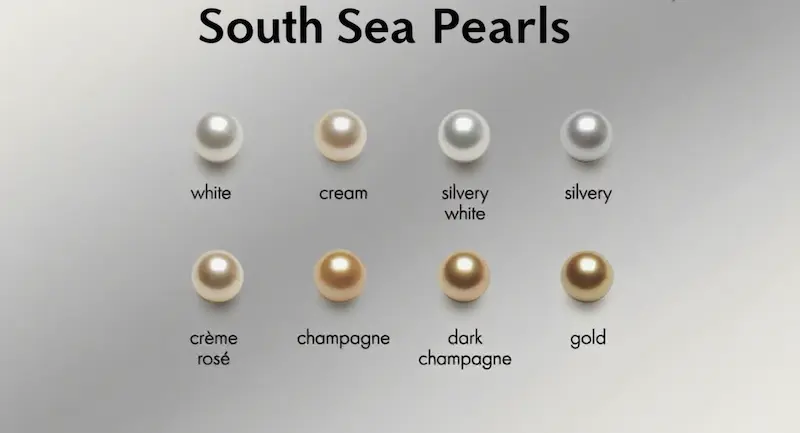
Because they’re grown for a longer time, usually 2-3 years, these pearls develop a really thick coating of nacre, often more than 2-3mm. That thick nacre is what makes them super strong and gives them that beautiful, deep, satiny shine – it’s different from the sharper reflection you see on Akoya pearls. South Sea pearls mainly come in two gorgeous types: White ones with silvery hints, and Golden ones that range from a champagne color to a rich, deep gold.
South Sea pearls are rare and large, making them a solid investment since their value often increases over time. Their impressive size makes them perfect for bold, eye-catching jewelry. And because they’re naturally stunning, they don’t need a lot of processing, which keeps their natural, organic charm.
3. Exotic Tahitian Pearls: The Dark Beauty
Tahitian pearls, which people often call “black pearls,” are a really striking option when exploring what are the different types of pearls. Even though they’re known as “black,” these beauties from French Polynesia actually come in all sorts of dark shades, like peacock green, eggplant purple, silver, and charcoal gray. And the way they shimmer and change color in different lights is pretty amazing.
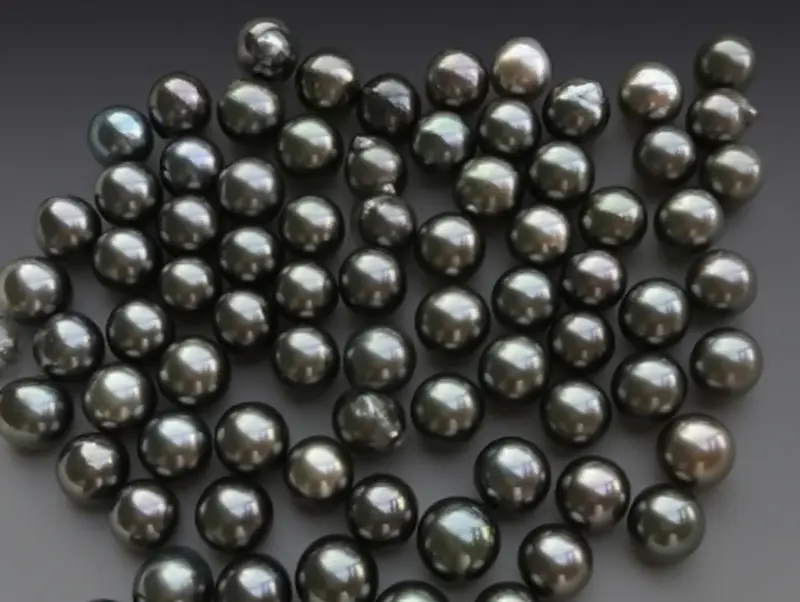
Tahitian pearls grow inside the Pinctada margaritifera oyster for about a year and a half to two years. They usually range from 8mm to 15mm in size. The fact that their black colors are completely natural is what makes them extra special – no dyes or treatments are involved. That makes them ideal for contemporary jewelry designs, and a fantastic pick if you’re looking for something a little more unconventional than the standard white pearl.
These pearls have become really popular with celebrities and people who love fashion, because they have a bold and sophisticated look.Because their colors differ naturally, each Tahitian pearl is unique. This makes them highly prized by collectors and designers alike.
Tahitian Pearl Color Spectrum
| Primary Color | Common Overtones | Rarity Level |
|---|---|---|
| Peacock Green | Purple, gold, rose | High |
| Aubergine | Purple, green | Medium |
| Silver | Green, blue | Medium |
| Charcoal | Purple, green | Common |
| Pistachio | Gold, rose | Very High |
4. Versatile Freshwater Pearls: The Value Champion

When considering what are the different types of pearls, freshwater pearls play a significant role.
Freshwater pearls are all the rage these days, and offer the most options when you’re looking at different kinds of pearls. Mostly grown in China using a specific type of mussel, they give you amazing quality for the price, with a gorgeous shine and a ton of natural colors to choose from.
Unlike saltwater pearls, these freshwater beauties can be grown in much bigger numbers per mussel. Some can even create up to 50 pearls at the same time! This efficient way of growing them, along with shorter growing times, makes freshwater pearls the most budget-friendly choice without skimping on quality.
They naturally come in colors like white, cream, peach, pink, lavender, and even chocolate, so there’s something for everyone and every skin tone. And get this – newer techniques are now producing perfectly round freshwater pearls that are just as good as Akoya pearls in shape, while still keeping that super thick coating that freshwater pearls are known for.
Pearls with unique shapes
Unique Baroque Pearls: Nature’s Artistic Expression
Baroque pearls are like nature’s little rebels! They’re basically saying, “Who needs to be perfect?” You can find these uniquely shaped pearls in all sorts of types—what are the different types of pearls—but they’re really common with freshwater pearls.

Baroque pearls are awesome because each one is unique – they’re all about celebrating what makes them different. Jewelry designers are all over them right now, using them in modern designs and really showing off those quirky, individual shapes. They aren’t trying to hide anything! Because of their irregular surfaces, they catch and reflect light in really interesting ways, making the jewelry sparkle and grab attention as you move.
These days, fashion loves baroque pearls because they represent being real and naturally beautiful. It’s a move away from the old idea that pearl jewelry has to be perfectly flawless. This trend has made baroque pearls a hit with younger people who dig their unique and slightly imperfect look.
Rare Keshi Pearls: The Accidental Treasures
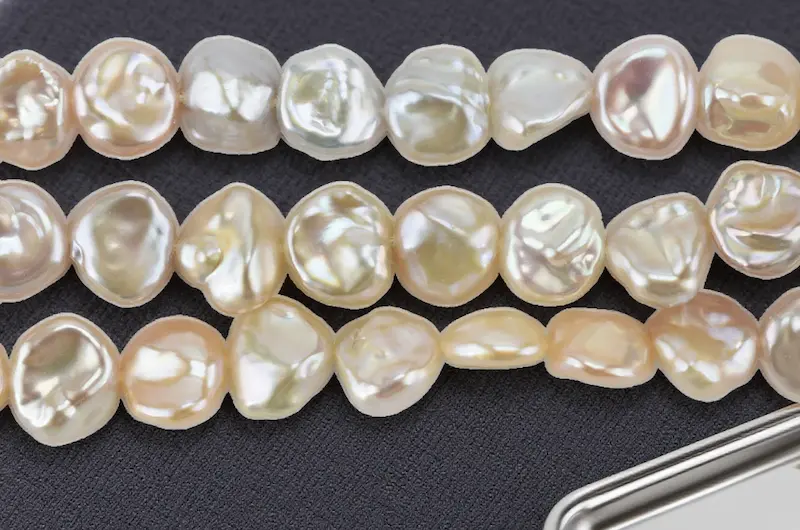
Keshi pearls, sometimes called “poppy seed pearls,” are accidental byproducts of the culturation process and represent some of the most interesting varieties when examining what are the different types of pearls. These solid-nacre gems form when the oyster rejects the implanted bead nucleus but continues producing nacre around tissue irritants.
Keshi pearls are special because they’re made entirely of nacre (that shimmery pearl stuff), without a bead inside. This gives them an amazing shine and a really cool way of playing with light. They’re usually kind of funky and irregular in shape, what you’d call “baroque.” You can find them in all sorts of cultured pearls, like Akoya, South Sea, and Tahitian. Since they’re basically happy accidents, they’re pretty rare and really sought after by pearl collectors.
The term “Keshi” comes from the Japanese word for poppy seeds, referring to their typically small size, though some can grow quite large. These pearls offer excellent value for their quality since their irregular shapes and accidental nature place them in a more affordable category despite their superior nacre composition.
7. Specialty Pearl Varieties: Mabe, Coin, and Soufflé Pearls
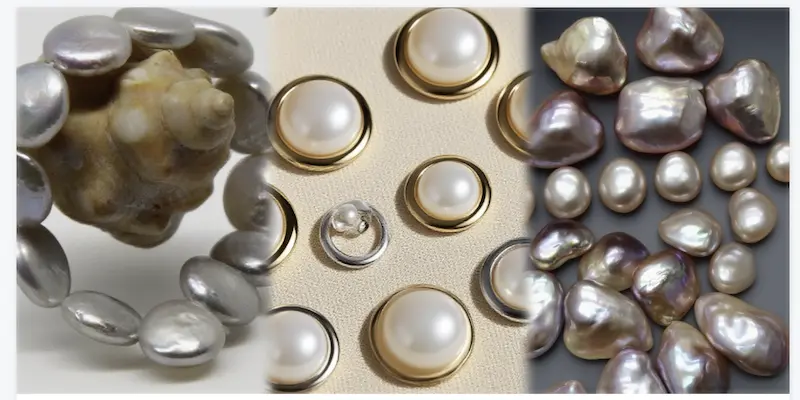
To answer what are the different types of pearls, there is so much more to pearls than the traditional round ones you see everywhere! When it comes to creating unique and intriguing jewelry, the astounding variety of pearl types available opens up a whole new creative realm. Furthermore, those distinctive shapes and formations have an impact on how designers create and incorporate them into their works, so it’s not just about appearances.
- Mabe pearls, or blister pearls, are cool because they grow stuck to the inside of the shell, instead of floating free. This makes one side flat and the other rounded, like a dome. They’re perfect for earrings and pendants because that flat side sits nicely against your skin.
- Coin pearls are made on purpose to be flat and round, like little discs or coins. They give you a lot of pearl for your money, since they have a big surface area but aren’t super heavy. They look really striking and modern in jewelry.
- Soufflé pearls are a newer thing. They’re freshwater pearls grown with a special trick that makes them big and lightweight, with a hollow inside. They can be HUGE, like 15-20mm, but still feel comfy to wear.
Specialty Pearl Comparison
| Pearl Type | Shape | Size Range | Primary Use |
|---|---|---|---|
| Mabe | Half-round dome | 12-20mm | Earrings, pendants |
| Coin | Flat disc | 10-16mm | Statement pieces |
| Soufflé | Round (hollow) | 15-20mm | Bold designs |
Factors Affecting Pearl Value and Selection
Understanding what are the different types of pearls goes beyond categorization to include the factors that determine their value and suitability for different purposes. The traditional grading criteria include luster, surface quality, shape, size, and color, but additional considerations affect the practical value of different pearl types.
- Luster quality remains the most important factor, with saltwater pearls generally exhibiting sharper reflection while freshwater pearls show a softer, more diffused glow.
- Surface quality varies significantly between types, with Akoya pearls typically showing the cleanest surfaces while baroque varieties embrace natural character marks.
- Nacre thickness directly impacts durability and longevity. Freshwater pearls excel in this category with their thick nacre layers, while some lower-grade saltwater pearls may have thin nacre that can wear over time.
- Size availability differs dramatically between types, with South Sea pearls offering the largest sizes and Akoya pearls typically remaining under 10mm.
When it comes to making pearl necklaces, some types are naturally better suited for creating a uniform look. Akoya pearls are fantastic for perfectly matched strands. Freshwater pearls are another good option if you’re looking for a more affordable way to get a well-matched necklace. Now, Tahitian and South Sea pearl necklaces often go in a different direction! They often celebrate the natural variations in color and size of the pearls. This creates a really stunning and visually interesting effect, especially when they’re used in graduated designs, where the pearls get bigger or smaller as they go along the strand.
Making the Right Pearl Choice for Your Needs
Selecting from what are the different types of pearls requires balancing personal preferences, intended use, and budget considerations. If you’re after classic elegance, particularly for those formal events, you really can’t go wrong with Akoya pearls. They’ve got that timeless beauty and are just perfect if you want a perfectly matched set of jewelry.
Those seeking luxury and investment potential should consider South Sea pearls, which combine impressive size with exceptional quality and strong resale value. Tahitian pearls appeal to individuals wanting unique color and contemporary style, while freshwater pearls provide excellent value for everyday wear and casual elegance.
Contemporary designers increasingly favor baroque and specialty pearls for their artistic potential and individuality. These varieties allow for creative expression and personal statement pieces that reflect the wearer’s unique style preferences.
- For beginners, freshwater pearls offer an excellent introduction to pearl ownership, providing quality, variety, and affordability.
- For collectors, focusing on specific types allows for deeper appreciation of their unique characteristics and market dynamics.
- For investment purposes, South Sea and high-quality Tahitian pearls typically offer the best long-term value retention.
Understanding Types and Quality for Informed Purchases
The pearl market continues evolving with new cultivation techniques and changing fashion preferences. Understanding these eight primary types—what are the different types of pearls—provides a solid foundation for navigating this beautiful and complex world, whether you’re making your first pearl purchase or expanding an existing collection.
When sourcing pearls for jewelry making or retail, working with reputable pearl suppliers who understand the nuances of different pearl types ensures you receive authentic, quality gems that meet your specific requirements. The diversity available in today’s market means there’s truly a perfect pearl type for every application, from classic strand necklaces to innovative contemporary designs.
According to the Gemological Institute of America, proper understanding of pearl types and quality factors is essential for making informed purchasing decisions in today’s diverse market.
By familiarizing yourself with what are the different types of pearls and their distinctive characteristics, you’re well-equipped to appreciate the subtle differences that make each variety special. Whether you’re drawn to the mirror-like perfection of Akoya pearls or the organic artistry of baroque varieties, each type offers its own pathway to experiencing the timeless beauty that has made pearls treasured throughout human history.
FAQs
When people are discussing what are the different types of pearls, these are the questions that usually come up:
Q: Which type of pearl is best?
A: The “best” type of pearl depends on personal preference and intended use.
Q: Which is the most expensive type of pearl?
A: South Sea pearls, particularly the white South Sea pearls, are generally considered the most expensive.
Q: What is the highest grade of pearls?
A: AAAAA is the highest grade of pearls.
Q: What is the rarest pearl type?
A: Natural black pearls are the rarest.


